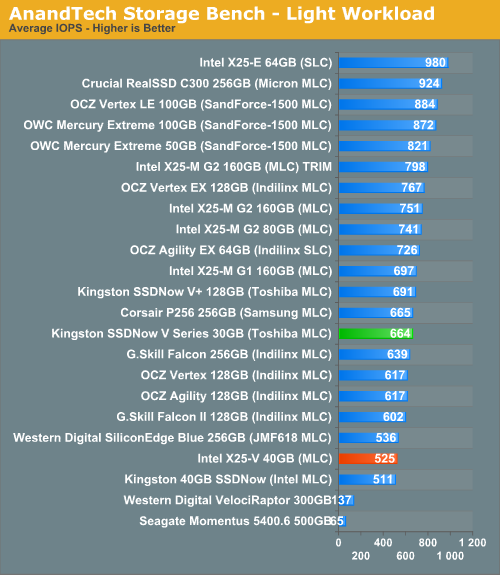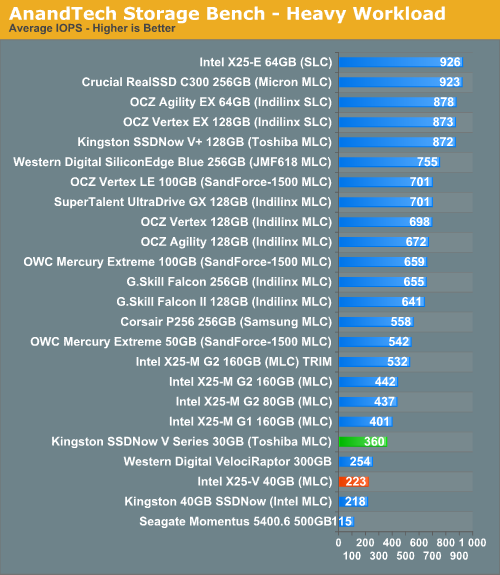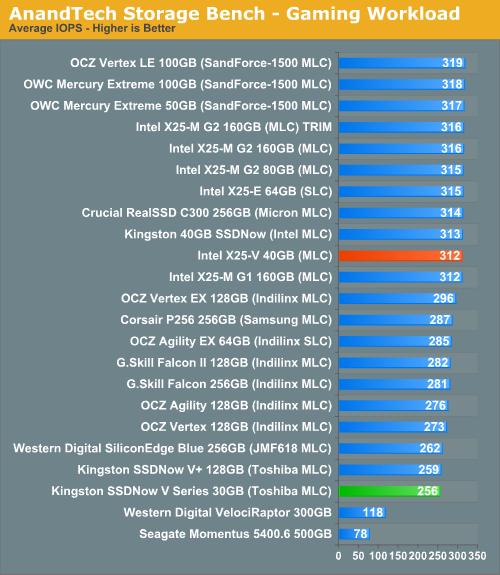Intel's X25-V & Kingston's 30GB SSDNow V Series: Battle of the $125 SSDs
by Anand Lal Shimpi on March 19, 2010 12:00 AM EST- Posted in
- Storage
AnandTech Storage Bench
Note that our 6Gbps controller driver isn't supported by our custom storage bench here, so the C300 results are only offered in 3Gbps mode.
The first in our benchmark suite is a light usage case. The Windows 7 system is loaded with Firefox, Office 2007 and Adobe Reader among other applications. With Firefox we browse web pages like Facebook, AnandTech, Digg and other sites. Outlook is also running and we use it to check emails, create and send a message with a PDF attachment. Adobe Reader is used to view some PDFs. Excel 2007 is used to create a spreadsheet, graphs and save the document. The same goes for Word 2007. We open and step through a presentation in PowerPoint 2007 received as an email attachment before saving it to the desktop. Finally we watch a bit of a Firefly episode in Windows Media Player 11.
There’s some level of multitasking going on here but it’s not unreasonable by any means. Generally the application tasks proceed linearly, with the exception of things like web browsing which may happen in between one of the other tasks.
The recording is played back on all of our drives here today. Remember that we’re isolating disk performance, all we’re doing is playing back every single disk access that happened in that ~5 minute period of usage. The light workload is composed of 37,501 reads and 20,268 writes. Over 30% of the IOs are 4KB, 11% are 16KB, 22% are 32KB and approximately 13% are 64KB in size. Less than 30% of the operations are absolutely sequential in nature. Average queue depth is 6.09 IOs.
The performance results are reported in average I/O Operations per Second (IOPS):

Intel's X25-V performs virtually identically to the older Kingston 40GB Boot Drive. The new 30GB drive does have the advantage though, performing much more like an Indilinx drive than a scaled down X25-M thanks to its higher sequential write speed.
If there’s a light usage case there’s bound to be a heavy one. In this test we have Microsoft Security Essentials running in the background with real time virus scanning enabled. We also perform a quick scan in the middle of the test. Firefox, Outlook, Excel, Word and Powerpoint are all used the same as they were in the light test. We add Photoshop CS4 to the mix, opening a bunch of 12MP images, editing them, then saving them as highly compressed JPGs for web publishing. Windows 7’s picture viewer is used to view a bunch of pictures on the hard drive. We use 7-zip to create and extract .7z archives. Downloading is also prominently featured in our heavy test; we download large files from the Internet during portions of the benchmark, as well as use uTorrent to grab a couple of torrents. Some of the applications in use are installed during the benchmark, Windows updates are also installed. Towards the end of the test we launch World of Warcraft, play for a few minutes, then delete the folder. This test also takes into account all of the disk accesses that happen while the OS is booting.
The benchmark is 22 minutes long and it consists of 128,895 read operations and 72,411 write operations. Roughly 44% of all IOs were sequential. Approximately 30% of all accesses were 4KB in size, 12% were 16KB in size, 14% were 32KB and 20% were 64KB. Average queue depth was 3.59.

Crank up the sequential writes and Kingston's lead grows. The 30GB V series drive almost performs like an X25-M G1 in this case. The X25-V on the other hand performs more like a low latency VelociRaptor. Still better than a hard drive, but don't expect to copy files any faster.
The gaming workload is made up of 75,206 read operations and only 4,592 write operations. Only 20% of the accesses are 4KB in size, nearly 40% are 64KB and 20% are 32KB. A whopping 69% of the IOs are sequential, meaning this is predominantly a sequential read benchmark. The average queue depth is 7.76 IOs.

With both Intel and Kingston equal in sequential read performance, the differentiating factor here is strictly random read performance where the X25-V has the edge.










78 Comments
View All Comments
Taft12 - Saturday, March 20, 2010 - link
The pricing changes every couple of minutes, what do you want?UPDATE 13: Zipzoomfly now has the Kingston drive for $84.77 beating Newegg's $84.99
hybrid2d4x4 - Friday, March 19, 2010 - link
Anand, in future SSD reviews, can you bring back the power consumption figures? Or maybe dedicate a short article that sums up the current lineup? I remember an article on Tom's which showed a huge amount of variance among 1st gen SSDs (with some being worse than "green" 3.5" HDDs) and am wondering how the current ones are versus a 2.5" laptop drive (ie: what impact a SSD swap will have on battery life).7Enigma - Saturday, March 20, 2010 - link
Agreed. I would be interested to see these figures as well. Doesn't really matter for a desktop setting but for a laptop replacement/upgrade it can be helpful.qwertymac93 - Friday, March 19, 2010 - link
so what your saying is...sandforce wins! Im kidding of course, but i think 30 gigs is too small, and the intel 40gig is too slow. too bad a 50 gig sandforce costs $250! o_Ompx - Friday, March 19, 2010 - link
If I had a small SSD, then I'd definitely use it as a cache, rather than as a boot drive. There are 2 popular solutions: ReadyBoost integrated in Windows 7, which supports up to 32GB of storage, matching these drives. There's also external program called ReadyBoost that can work with Window XP or Windows Server version.Nomgle - Wednesday, March 24, 2010 - link
ReadyBoost only caches Reads, and would be utterly useless in this scenario.As noted in the article, the "correct" way to use a small SSD is to install your OS directly onto it - use an additional mechanical drive as your main data store.
rivethead - Friday, March 19, 2010 - link
I guess I consider myself lucky that I purchased a Kingston SSDNow 40GB drive from Buy.com for $89. This was just eight weeks ago.A few hours of research and tweaking and a few aspirin later I was able to upgrade the firmware to the Intel firmware and enable TRIM.
So a big middle finger to you Intel.
Drakino - Friday, March 19, 2010 - link
Does the Intel drive adhere to connector location for 3.5 inch drives when mounted in the bracket? IE, can I toss the 2.5 inch drive onto the bracket, then mount the bracket in the drive carriers of a Mac Pro and plug it in?Western Digital failed this test with their initial release of the Velociraptor, only later coming out with a "Hot swappable" 3.5 inch form factor drive that adhered to SATA standards.
somedude1234 - Sunday, March 21, 2010 - link
I've been looking for a similar solution. Two similar items:Addonics Snap-In 25
Icy Dock MB882SP-1S-1B
Unfortunately, it looks like both of them use a separate PCB, which could possibly lead to connection problems.
I was looking for a dead-simple bracket that would offset the 2.5" drive to the proper location within a 3.5" drive space. The only candidate I've found so far is this:
Supermicro MCP-220-00043-0N
The pictures all show the complete Supermicro 3.5" hotswap carrier, including the metal bracket which properly places the 2.5" drive in the 3.5" drive space. It looks like the bracket is screw-mounted within the 3.5" carrier. I suspect that the MCP-220-00043-0N model number is actually for only the metal bracket and that the 3.5" hotswap carrier is simply shown for illustration. However, it's possible that they include both the bracket and the carrier. In that case, you could just remove the bracket and toss the carrier.
Nomgle - Wednesday, March 24, 2010 - link
The Icy Dock MB882SP-1S-2B and MB882SP-1S-1B work just fine to convert a 2.5" drive to a 3.5" form-factor, whilst keeping the SATA connectors in the right place -http://www.icydock.com/product/mb882sp-1s-2b.html">http://www.icydock.com/product/mb882sp-1s-2b.html and http://www.icydock.com/product/mb882sp-1s-1.html">http://www.icydock.com/product/mb882sp-1s-1.html